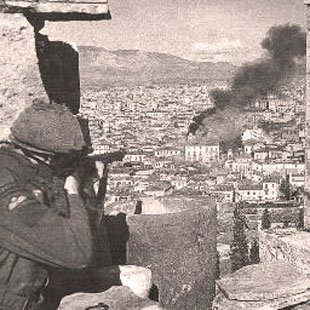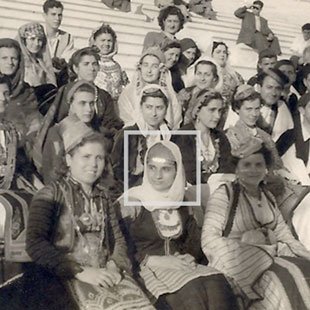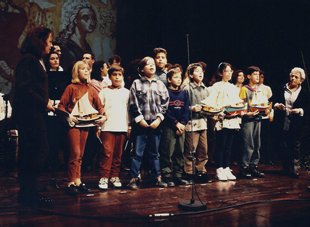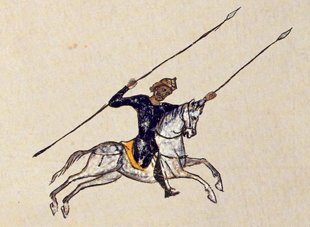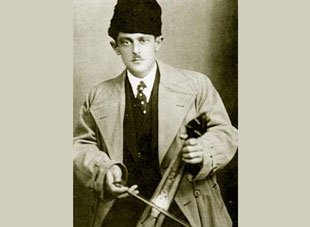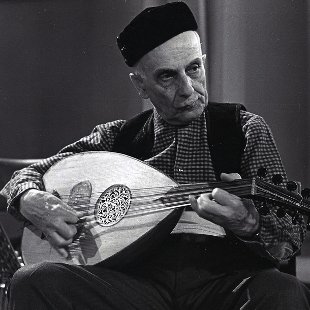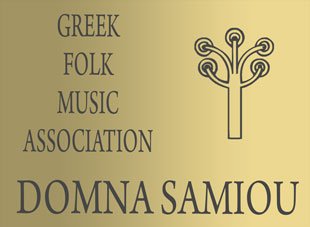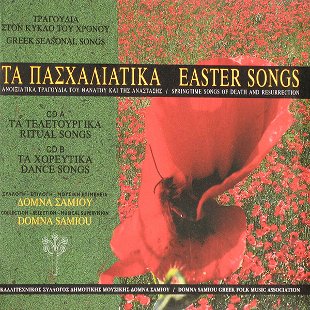You are at: Home page Her Work Discography Easter Songs
Contents
This significant edition aims to convey the spirit of Easter, the Christian feast celebrated amidst the glory and promise of springtime, through the selected rituals of that period of the year and their related sacred songs and tunes.
(barcode: 5204910000524)
Ritual Songs
-
1. Carnival Is Ended Now
Central Greece More
-
2. Now Is the Holy Time of Lent
Asia Minor More
-
3. Evyenoula
Cyclades More
-
4. Sweet Basil of the Holy Cross
Thessaly More
-
5. Zaphiris
Epirus More
-
6. It is the feast of Lazarus
Macedonia More
-
7. Im Wearing a White Rose
Macedonia More
-
8. A Teacher Seated Himself Down
Macedonia More
-
9. Good Women Bearing Palms
Macedonia More
-
10. Where Are You, Lazarus?
Central Greece More
-
11. Childrens Holy Week Song
More
-
12. Sounds from the Crucifixion service on Maundy Thursday
-
13. The Lament of the Virgin (Cyprus)
Cyprus More
-
14. The Lament of the Virgin (Thrace)
Thrace More
-
15. The Lament of the Virgin (Marmaras, Asia Minor)
Propontis More
-
16. The Lament of the Virgin (Phourni)
Eastern Aegean More
-
17. The Lament of the Virgin (Phourni)
Eastern Aegean More
-
18. The Lament of the Virgin (Reis-Dere)
Asia Minor More
-
19. The Lament of the Virgin (Pontus)
Pontus More
-
20. The Lament of the Virgin (Baidiri, Asia Minor)
Asia Minor More
-
21. The Lament of the Virgin (Mytilene)
Eastern Aegean More
-
22. Sounds From the Easter Service
-
23. Glory Be to Every Day
Ionian islands More
-
24. O Christ Is Risen
Asia Minor More
-
25. Today, Despo
Macedonia More
-
26. Now Hear Me,…
Macedonia More
-
27. Leilalim (Lilac-sweet)
Cappadocia / Konya More
-
28. The Swing
Cyclades More
-
29. The Roussalia
Central Greece More
Dance Songs
-
1. Today, My Dark-Eyed Beauty
Peloponnese More
-
2. Down in the Open Countryside
Peloponnese More
-
3. It’s Eastertime
Thrace More
-
4. Maria’ S Gone to Pick Some Lilac
Thrace More
-
5. Synkathistos
Thrace More
-
6. For a Whole Seven Weeks...
Asia Minor More
-
7. Again They Entered in the Dance
Asia Minor More
-
8. The May Month
Propontis More
-
9. Karsilamas Dance
Asia Minor More
-
10. Easter Couplets
Pontus More
-
11. O April, April, Cool and Fresh
Central Greece More
-
12. It Is May Month
Central Greece More
-
13. A Festival Is Being Held
Central Greece More
-
14. Easter Couplets
Crete More
-
15. My Son, Why Dont You Go and Wash?
Epirus More
-
16. Today, dear George...
Epirus More
-
17. Just Like Easter Sunday
Dodecanese More
-
18. Song of Saint George
Sporades More
-
19. All Attend at Church
Central Greece More
-
20. Melitzaniá
Cyclades More
-
21. Why, It Was Easter Day
Macedonia More
-
22. God Speed You Now, O Easter Day
Macedonia More
- Production: Domna Samiou Greek Folk Music Association
- Year of release: 1998
- Type: CD
- Sponsors: Marinopoulos Group
- Production Country: Greece
Notes
The symbolism of the sublime drama, Christ’s Passion, is rooted in the archetypal scheme of a contradiction; the god dies while the earth is re-born, he is buried amid a riotous display of Nature in bloom, and is interred beneath a mound of flowers. It is a fertilizing death. In acts of magic his ever-doubtful votaries attempt to influence the inscrutable will of spirits of the underworld and intrude their own overt and covert desires upon them. Annual regrowth, an outbreak of universal vitality, is a recurring event, each spring renewing a promise of eternity.
Besides attending church ceremonies, ingeniously harmonized with very ancient popular beliefs, modern Greeks devote themselves to their own solemnities that celebrate Nature in its springtime manifestations. They eat and drink together, they revive the songs that befit the slow pace of their sacred dances, and recall those who are absent, so restoring the wholeness of their community. The older ones remember, the younger are initiated, the women officiate. And then, through their Natureworshipping festivities, they pay homage both to the divine and to their own dead, trample death underfoot, glorify life, transcend finality, accepting their part in a never-ending process of repetition and restoration.
Miranda Terzopoulou (1998)
Easter has its roots in the worship practised by the ancient Egyptians who celebrated the spring equinox, that is to say, the moment in the year when the hours of day-time exceed those of night-time, when sunlight finally conquers darkness. This Egyptian festival, which was called Pisach, was adopted by the Jews and in succession by the Christians who identified it with the Passion and death of Christ, crucified on the Jewish Passover. The symbols of the ancient worship served as symbols of the new faith. Christ was identified with the sun and sin with darkness. The victory of day over night became the victory of the light of truth over the darkness of ignorance.
Apart from those features of the sun-worshipping festival of the Egyptians which it retained, the Christian festival of Easter embodied in its concept and ritual also many features of other forms of ancient worship performed at this time of the year when all Nature was reborn with precisely the same symbolism: the victory of life over death. Scholarly opinion holds that these Easter rituals, expressions of an anguished naturalistic expectation, rest upon primordial faith in the ‘annual demon’, that is, in a divinity or hero of vegetation who every year dies and is resurrected. At the same time the rituals aim, on the basis of the principles and practices of homeopathic magic, to assist growth and fertility by re-enacting this resurrection.
It is obvious that both the time and manner established for the celebration of Christian Easter were not matters of chance. That it was held during the most important and popular festival is because it coincided with ancient popular beliefs and corresponded with the innermost needs of the soul of pagan folk which persisted, and still persist, alongside Christian concepts. Again, it is not a matter of mere chance that, in contrast with the customs observed during the Twelve Days of Christmas and during Carnival, which are performed by men, the cycle of customs observed in springtime is the domain almost uniquely of women. This is so not only because their fertility was associated with the image of the explosive fertility of Nature at this season, but also because the element of necrolatry and the dirge-like character of the ceremonials refer directly to their daily occupations and evoke familiar emotions.
The identification of woman with the earth in combination with the idea of death, the subject of the rituals of both masked phallus-bearing men in wintertime and mourning women in springtime –rituals which, moreover, are performed for the most part in the countryside, on the bare ground– demonstrate that the earth is not only the recipient of the dead, but also the womb and nourisher of life. If these associations of winter customs were what once gave rise to a series of mimed symbolic practices around the ambivalent subject of ploughing and intercourse, of ploughshare and phallus, they now become the foundation of a series of ceremonial practices whose purpose is the emergence of life out of this dark symbolic womb, the magically fertilized earth.
The symbolic fertilizing action of phallic winter customs sows the seeds. The springtime customs of the women provide the setting for and promote the symbolic re-action of the earth as the life-forming womb which ‘rebirths’ whatever seed has been sown in its damp soil.
The Easter season opens in a sort of preparatory way with the end of the Triodion, the three-week period preceding the first Sunday of Lent. Clean Monday, a transitional and ambiguous day that belongs as much to Carnival as to Lent, is the bridge between the winter and spring festive cycles. The dressing-up, the liberality of the merrymaking, the excessive eating and drinking, albeit on fasting foods, prolong the Carnival spirit, but also mark its culmination.
However, as groups of merrymakers effect a general exodus into Nature’s own landscape, the festivity is transplanted from village squares and streets and finds a refuge in the countryside beyond the confines of human habitations, in short in the outside world. It is there that the cycle now is bid farewell and the hoped-for spring is given a prior welcome. Back in their homes the women scrupulously dispose of any remaining spicy foods and drive all tempting thoughts from their minds in preparation for the cathartic period of fasting and asceticism which will lead them, now in a state of purity, to the holy days of the Passion and the Resurrection.
The cathartic character of Lent is dressed up in the garb of Church ordinances that impose all kinds of prohibitions and call for the strengthening of religious feeling and strict self-control. It is understood there will be voluntary abstention from all merriment and, of course, from singing and dancing except in certain circumstances, for instance when the songs are dirges, when they are expedient on magical grounds, or when their occult meaning possesses a ritualistic and instructive character pertinent to the spirit of the season.
This period is marked by a series of customs of related content and symbolism. Some of them are concerned with the Christian calendar of feasts and the divine drama, others being wholly pagan in nature and following the sun in its course.
For example, there are visits to burial grounds for customary communication with the dead; girls making the round of the houses and collecting small change on the Sunday of the Veneration of the Cross; the children miming Lazarus; the ceremonies of initiation and house-rounds and collections made by youths taking part in Lazarus ceremonies; the women’s Moirolói or lament of the Virgin; the floral decoration of the bier of Christ as once of Adonis; and certain popular children’s play-acting concerned with resurrection from the dead. All these are accompanied by devotional, usually mourning, songs calling for fertility and abundance and sung in a notably theatrical manner. It may be said that many of these songs can be interpreted as an enactment prefiguring Christ’s own resurrection.
In so far as they preserve the most ancient form and the most sacred and dramatic character, the most interesting customs are some of those observed by adolescent girls. As games played by country children, they have survived till now in various parts of Greece: they are called Krantonelos in Mykonos, Phouskodendri in Stymphalia, Lidinos in Aigina, Kannavos in Pontos, and Zaphiris in Epiros, which has preserved most of the ceremonial features.
Essentially they are one and the same custom though known by different names and varying in their detail. The custom has grown up around the central theme of the laying-out and keening of an effigy of a dead man. Unless the part is played by a child, the effigy takes the form of a doll, often an ithyphallic one. It is ceremoniously decorated with flowers and herbs that possess certain magical properties. A funeral service is held and the corpse is then actually or symbolically buried. There follows its symbolic resurrection, something of which the bystander is made aware by the outburst of joy and the feasting that ensue. The effigy is destroyed as an act of expiation. The main part of the ‘game’, the keening, is accompanied by emotions and expressions of apparently genuine mourning and grief. This feature and other essential details of these performances, in particular their being enacted exclusively by maidens, reveal them to be profoundly religious in character as well as containing an element of fertility magic.
Scholars of comparative religion have plausibly seen a connection between these customs and the festivities accompanied by a show of great passion which were held by women in late antiquity in honour of Atys, Dionysos and, in particular, Adonis. Adonis, an exceptionally handsome mortal beloved by Aphrodite, was killed in the flower of his youth. These customs also belonged to Spring and were accompanied by similar ceremonials. In the course of these ceremonies, the Adoneia, mourning women cultivated ‘gardens’, sowing in small pots seeds of plants that grew and withered in a short space of time and decorating waxen effigies of the dead with flowers and these fresh green ‘gardens’. They went in procession round the streets and sang dirges while in a state of ecstasy. On finishing, they threw the small figurines into a well or river, and there followed a joyous, orgiastic feast celebrating the assumed resurrection of the dead person they had been worshipping.
The similarities are impressive, though the orgiastic element has been lost from the fertility feasts held by women in the folk practices of modern Greece; only the dirge remains. The persistence of this feature is evidence of the social nature of these youthful ‘games’, which also possess a magical character. Like all games, these too had an instructive purpose, namely, to initiate young girls into the woman’s role of layingout a corpse, to familiarize them with the apotropaic task of tending the dead, with the ritual of mourning and, above all, with the supreme art of the improvised moirolói or threnody which later on was to become part of their commonplace duties and occult occupations.
The image of girls keening the flower-strewn dummy of a dead person in Nature’s springtime setting readily conjures up in our eyes the familiar scene on the night of Maundy Thursday of women decorating the Epitaphios, the bier of Christ, and chanting a dirge for another handsome being while awaiting, indeed provoking, his resurrection.
Year after year this exclusively female custom continues to be performed inside the church, though it has nothing whatsoever to do with ecclesiastical practice. As soon as most lay folk and official clergy have left the church building, the women exercise their long-established right and begin to tend the man who was wrongly done to death, the only son of their protectress and mother goddess. While the younger women prepare the funeral, the older chant the Moirolói or Lament of the Virgin not only to keen the dead Christ but also to succour the Virgin, woman and mother, as a human being suffering the extreme experience of the death of her child.
Though the ritual performed during the night of Maundy Thursday concerns divine persons, it has all the characteristics of customs observed by women at critical moments in their lives, customs that give expression to a particular ‘womanly culture’ marked by the common experiences of their sex.
The same myth concerning the dead young man who ‘wastes away in corruption and rises up to immortality’, who in his resurrection renews hope and strengthens vital powers, is part of the cycle of customs associated with Lazarus. The memory of his lying dead for three days and being raised from his tomb, a foreshadowing of the resurrection of Jesus, was reflected in a popular and widespread festival which gave rise to a number of interesting customs of great significance.
An outstanding feature of the festival are the house-to-house visitations made on the feast of Lazarus that spill over into the following day, Palm Sunday. This custom of calling upon each household in turn is widespread throughout the Balkans and is of extraordinary variety as regards the number of participants, their sex, age, and social status, and the dramatic intensity of the event; similarly varied is their religious, worldly, and magical character especially in conjunction with what has already been mentioned in regard to the deeper meaning of the ritual in which they play a part.
More widespread still are the house calls made by children, especially by young girls. Carrying an effigy of Lazarus and small baskets decorated with flowers, they go from house to house relating in their songs the story of his death and resurrection, heightened by the impressions he obtained from his awful experience of the underworld. They ask for their reward in plain white eggs, nuts, and coins. Lazarus is portrayed either by a specially baked loaf in human form or by a doll suitably attired and decorated which they hold like an infant or carry on a pole and rock as long as they are singing. The oldest form of this custom, embodying a convincing representation of the resurrection, is to be found in Cyprus. There Lazarus is portrayed by a young boy covered from head to foot in seasonal yellow flowers as if wrapped in a shroud. The boy lies on the ground while the other children are chanting, and springs up as soon as he hears the message of resurrection delivered in their song.
In central and northern regions of Greece, the parading of Lazarus from house to house, often in conjunction with the younger children’s custom, is performed by adolescent girls who thereby acquire the honorific and usually lifelong title of ‘Lazarene’.
From a study of the earliest descriptions and most complete versions one may conclude much about the character of this custom. The houseround is part of a long ceremonial of complex significance, preparation for which commences days or even weeks earlier; participation in the ceremony requires certain qualifications and abilities. The girls are initiated under the leadership of an experienced Lazarene, in a place and in conditions of ceremonial seclusion and comradeship, often secured by an oath. All the girls are approaching or have reached nubile age. They receive instruction in the special songs and dances associated with the custom, and also learn the household tasks essential to their future role. Here, we should perhaps be speaking of rites of passage of a mundane, religious and social nature which lead the young girls out of childhood to maturity and marriage, presupposing their participation in the collective identity of the community.
Suitably prepared and in costumes appropriate to their age, the initiates join in the sacred processions as a single group and observe the strict procedures laid down. With a pious bearing consistent with the official form of worship, they commence their round of the community at the church and the priest’s house where they receive a blessing, often given by the priest’s daughter. They process right round the village singing the songs befitting the place occupied by each household in the hierarchy of the community, and end up back at the church where they dance as they sing their solemn songs.
These songs have nothing to do with the religious event commemorated by the feast day. Like the rest of their ceremonial, the songs are free of anything obviously symbolic of resurrection from the dead. Instead, what is apparent is the initiatory, fertilizing and social character of the custom which focusses on the brides to be who, both at the visual level, idealized as they are in their local costumes and by their actions, and at the spoken, with their springtime, erotic and complimentary songs, manifest their fecund nature to the whole community as they make one of their rare sanctioned appearances in a public place where marriages have their origin.
While the feast of Lazarus is associated with initiatory and fertilityworshipping customs observed by young girls, the next day, Palm Sunday, is dedicated to those who, above all, embody fertility and anxiously beg its blessing: the newly-wed women, the brides of the past twelvemonth. They are charged with cutting and carrying the palms, or some other stout growths, with which they are to decorate the church and which they will distribute to the congregation as amulets effective against the evil eye on account of their magical powers. They strike one another with the branches to raise their expectation that the fertilizing power of the leafy ever-greens will be communicated to themselves. In many regions on this day the house-calls begun on the feast of Lazarus are resumed. Interestingly enough, the effigy, ‘the Palm’, carried in the procession is of a girl in bridal dress.
The participation of the faithful in the Sacred Drama intensifies with the opening of Holy Week, and interest is directed to its innocent protagonist. So far, Gospel stories have underlain certain of the performances which have taken place outside the church. Now dramatic re-enactments are transferred into the church itself and follow the successive stages of the Passion. Holy Week services portray the progress of Jesus towards his death, not only in superb verbal, but also in theatrical images.
Both officiating clergy and the flock participate in these religious performances which develop from one day to the next. Participants assume a particular demeanour in church during the frequent evening services and outside it. The setting itself, the stage setting of the ceremonial, has been transformed: Nature with its abundance of blooms intoxicating the senses, the church with its mournful scenery, the houses in expectation of the coming festivity. Circumstances call for a change of rhythm and mood: schools close, family members living away from home are expected and welcomed, activities are curtailed, houses are swept and got ready, fasting becomes stricter as the temptations presented during the preparation of enticing ritual dishes become greater.
The degree of the individual’s participation in Holy Week increases with the events of the Crucifixion, the Descent from the Cross, and the Entombment. The procession of the Epitaphios marks the emotional climax; theatrically speaking, it is the most compelling phase in the unfolding drama of the Holy Passion. The procession encompasses all the dwellings and the cemetery too, it redefines the village boundaries and thus shields the village from all baneful outside influences so the community may devote itself without distraction to its own rites and occupations.
The procession of the faithful in which all take part, accompanying the ‘dead’ Christ bedecked with flowers, the total sense of communion in the redemptive act of the lament they all share in slowly leads the sacred drama from its culmination to its close and so to deliverance. The poetical phrasing of the encomia that are an outspoken protest against so insensate a death and an absolute refusal to accept it, is tantamount to a magical utterance that acquires the power to revoke the very fact of death. While the burial is even in progress, the process of resurrection is already in train.
The most profound message conveyed by the Resurrection lies in its sense of renewal. When one hears ‘the good word’, when it is passed on in a peal of bells and with a discharge of guns, in an embrace and benediction, when the new light bursts forth in joy, nothing can be as it was before. Easter Sunday and Easter Week that follows (called by a name in Greek implying its newness) with the customs and symbols related to them provide the framework of a collective magical act whose purpose is the reinforcement and renewal of life in all its forms. If the chief symbols of Easter –the egg, nucleus of existence; the colour red, colour of pulsating blood; the holy new light, brilliance of the never-setting and constantly re-born hope– are signs of the renewal of biological and spiritual life, the feasting at Easter is evidence of the renewal of social life.
Universal participation is the main characteristic of the celebration of Easter in Greece. Even in our day and age, the atavistic habit of modern Greeks to return to their native land at this time of the year revitalizes the communities. The staid ‘grand dance’ that opens in the forecourt of the church following the Second Resurrection –virtually an extension of the ritual inside– in which even the clergy and the distressed are expected to join in the precise order and formal manner that becomes the hierarchic nature of the closed community, depicts values that it would be difficult to express in words. The codes of conduct which have come about in the course of the turbulent past have shaped the practices that are necessary to convert a religious ceremony into the means for propagating those qualities that allow for the instruction and admission of new members into the group. This practical bolstering of the collective conscience, essential if every natural and supernatural threat is to be confronted, is achieved largely through ritual songs.
Easter songs with their carefully selected themes –most of them are sung only on this particular day– induce in the performers solemn reflections upon death, but also upon the perpetuation of life through the succession of generations, upon the experiences undergone by the race and the lessons to be learnt from history, and finally upon whatever poses a threat to the physical or moral existence of the community.
Two great dangers constantly face the closed farming community: barrenness of the soil and barrenness of its women, and the imbalance that occurs in the society through loss of its members. Such a loss, other than through natural deaths, may be brought about by any one of those specific causes which for centuries have posed a threat to Hellenism: war and captivity, abduction and recantation, and emigration and violent death. To these must be added moral causes such as a lapse from the social order or a breach of it, either one alienating the individual from the group.
Songs of an imposing poetical inventiveness and evocative in their performance are part of the community’s attempt within the prescriptive framework of ceremonial entertainment to control whatever threatens it. These songs vary not only from region to region but also from village to village. Each version records a particular incident, an instance of danger and survival, doubt and vindication, error and punishment. Each is a metaphoric rendering of some aspect of local history, each insists on jogging the memory, and creates the need for a reaffirmation of individual and collective identity. Emotional participation, the potency of a symbolic poetic language which causes any anxiety, supplication or hope to be shared by all, which establishes precepts and limitations, succour and relieve the individual. Performers of the songs and their audience, givers and receivers of tradition, interpreters of hidden meanings, place themselves in the legendary past of the community, re-adopt their customary values, are prepared as a body to adapt smoothly to any changes, and ensure continuity by handing down the sum of collective knowledge they have acquired to the younger generation and to newcomers alike and by showing them how to embrace their own history.
Miranda Terzopoulou (1998)
Easter dances commence even before Holy Week on account of the raising from the dead of an ordinary individual, ‘Poor Lazarus’. These dances, performed on ‘Lazarus Saturday’ and the next day, Palm Sunday, are distinguished by their simple steps and movements. As mentioned elsewhere in greater detail in the essay of Miranda Terzopoulou ‘and Eros Danced with Fair April…’, only young unmarried girls take part in the ceremonial practice of calling upon every household on Lazarus’ feast day. Their dance, conforming with age-old canons of strict social demeanour, is one of the most conservative in its movements. Moreover, the youthful age of the participants means that they lack the necessary maturity as dancers to give their performance a more creative, collective expression by developing or establishing new patterns of movement, or at least by embellishing the old with innovative display.
In the course of its house-to-house round on Lazarus’ day, the dance takes two forms. The first is as a dance performed in the streets or lanes in a manner facilitating the movement of the girls through the village, since they must call on every house and address it with their song. Although one might expect dancing in village lanes would allow a certain freedom of movement, there are, once again, limitations. As the Lazarenes accompany their dance with singing and must maintain a steady rhythm in both their voice and movement for many hours on end, they progress with regular, simple steps without any evolutions.
The second and more conventional form of the Lazarenes’ performance is the dances they present on the village square. Despite the peculiarities of local forms, there are many similarities to be observed in the execution of these dances. The basic type of movement is distinguished by the simplicity of both the steps and the motion of the dancers. An exception to the straightforward execution of the dance lies in the minor improvisations introduced by the lead dancer and the initiatives she takes. In some instances the lead dancer is one and the same throughout the day, in others two girls alternately lead the group, while in yet others each dancer takes her turn in the kávo or lead position. In contrast with the dances executed in the lanes with a certain sense of haste, the more ceremonious dance performed on the village square is a slow one in order that it should last as long as possible and so allow the lead dancer to complete a full circle.
In some villages the completion of a full circle of the dance is the sign for the day’s festivities to be brought to a close. Elsewhere, on the contrary, it is the signal for more general celebrations to commence, reflecting the view that the raising of Lazarus, referred to as the first Resurrection, foreshadows the Resurrection of Christ. These festivities, in which young unmarried men take part, lead on to engagements and marriages, confirming the idea that the customs associated with the feast day of Lazarus provide a setting for what may be the most important ‘bride-market’ of the year.
Unlike the ‘Lazarenes’ dances, Easter dances are notable for the participation in them of all the inhabitants of the village. They begin after the church service of the second Resurrection either in the morning or in the afternoon of Easter Sunday and in the forecourt of the church or on the village square. They are repeated daily, normally till Easter Tuesday, but in several localities till Friday of Easter Week, feast of the Virgin Fount of Life, or till the following Sunday, feast of Saint Thomas, and even up to Pentecost.
Like the dances on Lazarus’ feast day, Easter dances are accompanied only by specific songs sung by the dancers, and employ ordinary simple steps. The positions occupied by participants in the dance and the intricacy of their movements are of particular interest.
The order of the dancers is determined by the strict rules establishing the social hierarchy. Thus the position of the lead dancer is filled by the priest most senior in years, who is followed by the other clergy, if any. Next come the men of the community, again in order of age. The women either follow on according to their seniority –first the eldest, married women and then the younger, and at the end the unmarried girls and children–, or they form an independent circle inside or outside the men’s. Almost always the dancers hold each other either arm-in-arm or with their arms cross-linked so as visually to suggest the coherent nature of the fabric of the community. Where there are two concentric circles, from time to time the two groups will smoothly coalesce and form a single circle reflecting the hieratic order of the entire population.
Occasions when the dancers kiss the priests’ hands before taking their place in the circle, or start by singing ‘Christ is risen!’ during the first dance or by dancing three times round the church draw attention to the magicoreligious character of the performance, above all to the sanctity with which the performers regard the dance.
Kangelária and kangeleftí are typical of the dances performed at Eastertime in northern Greece. Arm-in-arm, the dancers sing antiphonally, first the men and then the women. The dancers occupying the first and second positions and taking their cues from the verses of one particular song lead the chain of dancers in a tortuous and coiling movement which the whole group follows over the dance space; in another dance they have the dancers pass beneath the arch they form with their arms.
A distinct feature of ceremonial Easter dances are the ‘duplex’ dances occurring in a variety of local forms. Besides the two concentric circles and the single circle composed of separate groups of men and women, the most interesting example of the duplex dance is to be found in the two-tier or ‘upper’ dance.
According to written or oral sources, duplex dances occur all over Greece and Asia Minor. Despite the small local touches that distinguish and characterize each region, what is common to all duplex dances is their structural similarity and the coincidence of the day, Tuesday of Easter Week, on which they are performed, accompanied by only the appropriate local song, sung acapella. They are danced by an even number of men, the same number forming the upper and lower tiers. It seems to be commonly agreed that the ideal number is twenty in all. Half of these, who must belong to the same social group –for instance, all must be engaged to marry–, form a closed circle, the arms of each dancer resting on the shoulders of the men to his left and right. The other half, a similar number of men belonging to another social group such as the married, now climb onto their shoulders with or without help from a man standing in the centre of the circle. Once they are aloft, again holding each other by the shoulders, all break into the song traditionally sung in their particular locality, while those of the lower tier move rhythmically in a clockwise direction till the song is finished, at which point the dancing stops to be resumed only after another year has passed.
In regions such as the Greek islands where no festivities mark the day that Lazarus is commemorated, it is the unmarried girls who open the dancing on Easter Sunday. They dance and sing acapella, in particular specific Easter songs such as ‘Just like Easter Sunday’ sung in Kastelorizo, and ‘Saint George’ in Skiathos. It is the same with the women’s tráta dances performed in Salamis and at Megara on Easter Tuesday.
To summarize, what characterizes Easter dances is first of all their interrelationship and the combination of dances and songs peculiar to the day, their performance unaccompanied by instrumental music, and the simplicity of the steps, allowing the dancers to give all their attention to the words of the songs which often determine the pattern of the movement. Another characteristic is the virtual obligation upon all to participate, considered essential for the well-being of the entire community. Moreover, the profound significance of the songs, the staid structure of the dance, the passing beneath human arches, and the twisting movement, taken in conjunction with complex holds, comprise a dance ceremonial to which are attributed supernatural powers of inducing fertility. Some hold the view that Easter dances are merely springtime revelry. But the degree of chagrin and concern felt by dancers whenever a natural disaster, be it a flood or earthquake or death, prevents the Tranós or Grand Dance being performed is a measure of the profoundly magic-religious significance they attribute to it.
Zoe Margari (1998)
Bibliography
Alexiou, Margaret, The ritual lament in Greek Tradition, Cambridge University Press, 1974.
Apostolidis, I., «Από τα τραγούδια της Ιερισσού», Χρονικά της Χαλκιδικής 3, 84-86, Thessaloniki: Chalkidiki Historical and Folklore Society, 1962.
Bouvier, Β., Le Mirologue de la Vierge I. La chanson populaire du Vendredi Saint, Geneva 1976.
Ekonomidis, Dim., «Λαογραφική έρευνα εις Μονοδένδριον και Βίτσαν Ζαγορίου Ηπείρου (1966)» Επετηρίς ΚΕΕΛ 18-19 (1965-6), Athens 1967, 285-6.
Ireiotis, N., «Ό χορός της Λαμπρής ιδία εν τη εν Αιγίνη Παλαιά Χώρα», Λαογραφία 8, (1921), 67-108.
Kakouri, Katerina, Προϊστορία του θεάτρου, Athens 1974.
Kakouri, Katerina, «Ό χορός και η μαγεία στις ρίζες του θεάτρου», Θέατρο 20 (1965) 76-82.
Kakouri, Katerina, Θάνατος - Ανάσταση σε μαγικο-θρησκευτικά ‘δρώμενα’ της λαϊκής λατρείας της Ηπείρου, Athens 1965.
Karakassis, S., «Μουσική Αποστολή εις Χαλκιδικήν», Επετηρίς Λαογραφικού Αρχείου 11-12, 333-341, Athens: Academy of Athens, 1958-59.
Kostakis Th., Η Ανακού, Athens: Centre for Asia Minor Studies, 1963.
Loukatos, D., Πασχαλινά και της Άνοιξης, Athens: Philippotis, 1980.
Loukatos, D., Συμπληρωματικά του χειμώνα και της άνοιξης, Athens: Philippotis, 1985.
Loukopoulos, D., «Σύμμεικτα Λαογραφικά της Μακεδονίας», Λαογραφία 6, 99-168, Athens: Greek Folklore Society, 1917.
Loukopoulos, D., «Σύμμεικτα Αιτωλικά Λαογραφικά», Λαογραφία 8, 13-66, Athens: Greek Folklore Society, 1921.
Loukopoulos, D. and Petropoulos, D., Η Λαϊκή Λατρεία των Φαράσσων, Athens: Centre for Asia Minor Studies, 1949.
Lykessas, G., Οι Ελληνικοί χοροί, 2nd edition. Thessaloniki: University Studio Press, 1993.
Megas, G. A., Ελληνικαί Εορταί και έθιμα της Λαϊκής Λατρείας, Athens: Odysseas, 1988.
Melikis, G., Λαογραφικά της Μελίκης, vol. 1 [1984].
Nazou, Despina, «Στο πνεύμα της Σαρακοστής», newspaper Η Μυκονιάτικη, March 1996, 10.
Nilsson M., Ελληνική λαϊκή θρησκεία, Athens, 1966.
Panayiotopoulou Anna, Νεοελληνικός χορός. Το χορολογικό φαινόμενο της επαρχίας Δωρίδας. Χορογέννηση και χορογραφία του Νεοελληνικού Χορού, Athens: Telethrion, 1995.
Petridis Th., «Ό δίπατος χορός», 3ο Συμπόσιο Λαογραφίας Βορειοελλαδικού χώρου, 593-626, Thessaloniki: Foundation for Balkan Studies, 1979.
Politis, N. G., «Τα δημώδη ελληνικά άσματα περί της δρακοντοκτονίας του Αγίου Γεωργίου», Λαογραφία 4 (1913-14) 185-235.
Puchner Walter, Λαϊκό θέατρο στην Ελλάδα και στα Βαλκάνια, Athens: Patakis,1989.
Siambanopoulos, K., Οι Λαζαρίνες, Thessaloniki, 1988.
Takadopoulos, L., Η Σινασσός που έσβησε, Athens: e New Sinassos Society, 1982.
Zenkinis, Efstratios, «Εορτολόγιο και αγιολατρεία των Μπεκτασήδων της Δ. Θράκης», Πρακτικά Στ’ Συμποσίου Λαογραφίας Βορειοελλαδικού χώρου (1989), Thessaloniki, 1991, 77-94.
Zervoudakis, S., «Τα ήθη ... Καισαρείας Καππαδοκίας», Ξενοφάνης 1/8 (1986), 365-382.
Credits
Production team
- Domna Samiou (Research, Collection, Musical supervision),
- Domna Samiou (Production management),
- Miranda Terzopoulou (Production management),
- Socrates Sinopoulos (Assistant musical supervisor),
- Tasia Papanikolaou (Production assistant),
- Yiorgos Ε. Papadakis (Musical advisor)
Sound team
- Spyros Drossos (Sound engineer),
- Andreas Mandopoulos (Sound engineer),
- Yannis Sygletos (Sound engineer),
- Vassilis Vassilakis (Sound engineer),
- Christos Hadjistamou (Sound editing),
- Andreas Mandopoulos (Sound editing)
Booklet team
- Zoe N. Margari (Texts and commentaries),
- Miranda Terzopoulou (Texts and commentaries),
- John Leatham (English translation),
- Diana Louis (English translation),
- Georgia Papageorgiou (Text Editing),
- Yulie Papatheodorou (Text Editing),
- Miranda Terzopoulou (Text Editing),
- Lika Florou (Design and layout)
Singer
- Domna Samiou (The Lament of the Virgin (Mytilene), The Lament of the Virgin (Cyprus), Now Is the Holy Time of Lent, Why, It Was Easter Day, Evyenoula, Carnival Is Ended Now, All Attend at Church, Just Like Easter Sunday, Today, My Dark-Eyed Beauty, The Lament of the Virgin (Marmaras, Asia Minor), For a Whole Seven Weeks..., The May Month, O Christ Is Risen, The Lament of the Virgin (Pontus), The Lament of the Virgin (Thrace), The Lament of the Virgin (Baidiri, Asia Minor), The Lament of the Virgin (Phourni), Again They Entered in the Dance),
- Yiorgos Amarantidis (Easter Couplets),
- Eleni Bayraktari-Koutalakidou (The Lament of the Virgin (Mytilene), The Lament of the Virgin (Marmaras, Asia Minor), The Lament of the Virgin (Pontus), The Lament of the Virgin (Thrace), The Lament of the Virgin (Baidiri, Asia Minor), The Lament of the Virgin (Phourni)),
- Children's Group of the 6th Primary School of Nea Smyrni (Sweet Basil of the Holy Cross, Childrens Holy Week Song),
- Vassiliki Danga (Today, Despo),
- Lambriana Doitsidi (Maria’ S Gone to Pick Some Lilac, It’s Eastertime),
- Morfo Doitsidi (The Lament of the Virgin (Mytilene), The Lament of the Virgin (Marmaras, Asia Minor), The Lament of the Virgin (Pontus), The Lament of the Virgin (Thrace), The Lament of the Virgin (Baidiri, Asia Minor), The Lament of the Virgin (Phourni)),
- Theopoula Doitsidi (The Lament of the Virgin (Mytilene), Maria’ S Gone to Pick Some Lilac, It’s Eastertime, The Lament of the Virgin (Marmaras, Asia Minor), The Lament of the Virgin (Pontus), The Lament of the Virgin (Thrace), The Lament of the Virgin (Baidiri, Asia Minor), The Lament of the Virgin (Phourni)),
- Fragiskos Fatouros (Glory Be to Every Day),
- Stergiani Gourtzoumi (A Teacher Seated Himself Down),
- Sophia Korre (The Swing),
- Maria Kouskousi (The Lament of the Virgin (Reis-Dere)),
- Antonis Kyritsis (Today, dear George..., My Son, Why Dont You Go and Wash?, A Festival Is Being Held),
- Irini Markaki (The Lament of the Virgin (Phourni)),
- Androniki Martino (Zaphiris),
- Men's Group of the Ethnografical Foundation of Megara (Attiki) (The Roussalia),
- Thanassis Moraitis (Down in the Open Countryside),
- Zacharoula Motska (Zaphiris),
- Thalia Spanou (The Lament of the Virgin (Mytilene), The Lament of the Virgin (Marmaras, Asia Minor), The Lament of the Virgin (Pontus), The Lament of the Virgin (Thrace), The Lament of the Virgin (Baidiri, Asia Minor), The Lament of the Virgin (Phourni)),
- Andreas Varvatakis (Easter Couplets),
- Women's Group from Agia Paraskevi (Kozani) (Im Wearing a White Rose),
- Women's Group from Sarakina (Grevena) (Good Women Bearing Palms),
- Women's Group from the cultural branch N. Karvalis of the Centre for Cappadocian Studies (Leilalim (Lilac-sweet))
Choir
- Children's Choir of the mixed High School 'Estia Neas Smyrnis' (Where Are You, Lazarus?),
- Domna Samiou Greek Folk Music Association Choir (Song of Saint George, Glory Be to Every Day, Evyenoula, Now Hear Me,…, The Swing, Carnival Is Ended Now, All Attend at Church, Today, My Dark-Eyed Beauty, For a Whole Seven Weeks..., The May Month),
- Group from the Ethnological Dancing Association of Amfiklia 'Dadiotiki Estia' (O April, April, Cool and Fresh, A Festival Is Being Held, It Is May Month),
- Popular Choir of the Amelioration and Education Club of Deskati (Grevena) (God Speed You Now, O Easter Day),
- Young girls from Aiani (Kozani) (It is the feast of Lazarus)
Clarinet
- Nikos Philippidis (Why, It Was Easter Day, Today, dear George..., My Son, Why Dont You Go and Wash?, Maria’ S Gone to Pick Some Lilac, It’s Eastertime, Today, My Dark-Eyed Beauty, Down in the Open Countryside, Synkathistos),
- Panagiotis Plastiras (O April, April, Cool and Fresh, A Festival Is Being Held, It Is May Month)
Violin
- Lazaros Efthymiou (Today, dear George..., My Son, Why Dont You Go and Wash?),
- Yiorgos Marinakis (Song of Saint George, Why, It Was Easter Day, Carnival Is Ended Now, Maria’ S Gone to Pick Some Lilac, It’s Eastertime, All Attend at Church, Just Like Easter Sunday, Today, My Dark-Eyed Beauty, Down in the Open Countryside, For a Whole Seven Weeks..., The May Month, Again They Entered in the Dance, Synkathistos, Karsilamas Dance, Melitzaniá)
Cretan lyra
Constantinopolitan lyra
Pontic lyra
Kanun
- Panos Dimitrakopoulos (For a Whole Seven Weeks..., The May Month, O Christ Is Risen, Again They Entered in the Dance, Karsilamas Dance)
Constantinopolitan lute
- Socrates Sinopoulos (Song of Saint George, Why, It Was Easter Day, Carnival Is Ended Now, Maria’ S Gone to Pick Some Lilac, It’s Eastertime, All Attend at Church, Just Like Easter Sunday, Today, My Dark-Eyed Beauty, Down in the Open Countryside, For a Whole Seven Weeks..., The May Month, O Christ Is Risen, Again They Entered in the Dance, Synkathistos, Karsilamas Dance, Melitzaniá)
Santur
- Konstantia Kapetanopoulou (Song of Saint George, Carnival Is Ended Now, All Attend at Church, Just Like Easter Sunday, Melitzaniá)
Lute
- Manolis Peristeris (Easter Couplets),
- Kostas Philippidis (Song of Saint George, Why, It Was Easter Day, Today, dear George..., My Son, Why Dont You Go and Wash?, O April, April, Cool and Fresh, A Festival Is Being Held, Carnival Is Ended Now, It Is May Month, Maria’ S Gone to Pick Some Lilac, It’s Eastertime, All Attend at Church, Just Like Easter Sunday, Today, My Dark-Eyed Beauty, Down in the Open Countryside, For a Whole Seven Weeks..., The May Month, Again They Entered in the Dance, Synkathistos, Karsilamas Dance, Melitzaniá),
- Andreas Varvatakis (Easter Couplets)
Ney
Daouli (davul)
- Yiorgos Gevgelis (Now Hear Me,…, O April, April, Cool and Fresh, A Festival Is Being Held, It Is May Month, Today, My Dark-Eyed Beauty, Down in the Open Countryside, Easter Couplets)
Goblet drum
- Yiorgos Gevgelis (Why, It Was Easter Day, Maria’ S Gone to Pick Some Lilac, It’s Eastertime, Synkathistos),
- Katerina Mitropoulou (Carnival Is Ended Now),
- Andreas Pappas (For a Whole Seven Weeks..., The May Month, Again They Entered in the Dance, Karsilamas Dance)
Bendir (frame drum)
Tambourine
- Spyros Alevrontas (Today, dear George..., My Son, Why Dont You Go and Wash?)
Zil bells
Informant (source of the song)
- Father-Alexandros Filippakis (Glory Be to Every Day),
- Maria Karamblaka (For a Whole Seven Weeks..., O Christ Is Risen),
- Sophia Korre (The Swing),
- Panagiota Nazou (Evyenoula),
- Yannis Parisis (Song of Saint George),
- Katerina Seferli (All Attend at Church),
- Yiorgos Tzitzos (Why, It Was Easter Day),
- Roula Tzitzou (Why, It Was Easter Day)
References

Domna's song collection for Easter

Singing Spring
Member Comments
Post a comment
See also
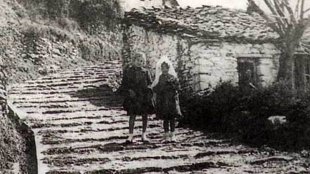
Song
Sweet Basil of the Holy Cross
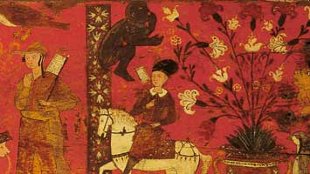
Song
Arta’s Bridge

Song
Evyenoula

Song
Glory Be to Every Day

Song
Now Hear Me,…

Song
Now Is the Holy Time of Lent

Singing Spring
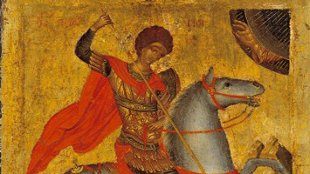
Song
Song of Saint George

Song
The Lament of the Virgin (Cyprus)

Song
The Lament of the Virgin (Mytilene)

Song
The Lament of the Virgin (Reis-Dere)

Song
Today, dear George...

